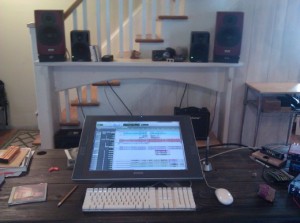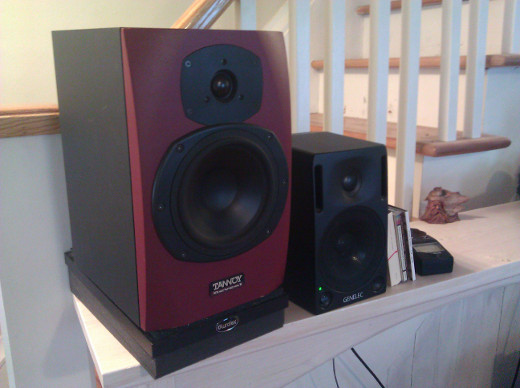Auralex ProPAD, ProPAD XL, & SubDude Review — by Carmen Borgia
Sound is crazy. It travels in invisible waves, difficult, if not impossible to visualize. With the right speakers you hear what was recorded and mixed in the original studio, no extra or missing frequencies, the balances hold up.

The Auralex ProPAD and ProPAD XL monitor isolators feature 3-layer highly damped construction for the studio.
Likewise, we trust our speakers to give us an even and reliable sound that is balanced across the frequency spectrum…which allows we mixers to make mixes that hold up well out in the world.
But once we put a set of speakers in a room, we also hear…the room! The room has a shape, the room has resonances — it has a particular character determined by the size, the shape and the surfaces in the room. Also consider the furniture, people and the stuff that all rooms tend to attract. (I recall a little buzz I thought was in the recording but turned out to be the Johnny Cash action figure sitting by the console, vibing sympathetically with the music in the room. I should have put a mic on him.)
The speaker driver vibrates and interacts with the speaker cabinet, making the cabinet vibrate too. So, we choose a speaker and cabinet that have been designed to sound best together.
In a simpler reality, that would be the end of it. But the vibrations of the speaker cabinets in turn are passed on to whatever they physically touch, which colors what we hear. If we can eliminate or minimize the mechanical coupling of the speaker to the room, that can help the monitors reach their design potential.
To that objective, Auralex ProPADs are intended to enhance monitor speaker performance by decoupling the monitors from the shelf, meter bridge or table upon which they rest.
PRODUCT DESCRIPTION
These look simple and effective right out of the box. The ProPADs are three layers of materials – in the middle is a piece of ¾” medium density fiberboard (MDF) with a melamine finish. On the top side is a 5/16” inch layer of heavy recycled rubber, black with white flecks; Auralex calls it “Iso-Plate” which has the feel and faint aroma of a tire.
On the bottom of the MDF is a different variety of foam with the trade name “Platfoam”. This material is gray and feels like the foam panels that Auralex makes to treat walls, but a bit stiffer.
Part of the art of soundproofing involves layering different densities of materials to better control sound transmission, so this design is intuitive. ProPADs come in two sizes, regular (8” x 13” x 2.125”) and XL (13” x 19” x 2.125”), they are otherwise identical. They come with an additional piece of wedge shaped Platfoam for each ProPAD for adding a few degrees of tilt should your speakers need aiming. The pieces are simple and handsome, and they would blend in with most any studio. For this review I used the smaller ProPADs since they matched the size of my speakers.
INSTALLATION
Installation is very old school – no downloads, no dongles, no serial numbers are required – just as nature intended! Lift up each speaker and slide the ProPAD underneath, Iso-Plate side up. If the speakers are not on axis with your ears, insert the angled Platfoam beneath the ProPAD to make it right.
IN USE
I tried out the ProPADs in a studio that is still in progress. The furniture is a bit improvised and the walls have not been treated. In listening, the soundstage is kind of smeared and ill-defined. The mid-priced stereo speaker array is functional enough for simple work.
On the audio post side, I design and mix sound for broadcast, the Web and theatrical release. Music work includes tracking and mixing solo acts and bands. Every now and then someone calls to migrate a stack of hoarded analog tape to digital. So a typical day may include mixing, noise reduction, song arranging or even Foley recording — this range of work requires as much accuracy from my monitors as possible. Any improvement here would be useful.
I set up listening tests with and without the ProPADs. Because I had to physically swap the pads in and out between listenings I couldn’t do a blind A/B. I was emotionally preparing myself to not hear much of a difference given all the other issues in the room.
First up was a mix for a powerful, driving rock song with male vocals. I listened to several passes without the pads and then slid them beneath each speaker.
The difference was significant. The bass was tighter, there was more detail in the high mids as well. The ProPADs had raised the speakers by a couple of inches, so I added the Platfoam wedge to aim the tweeters more precisely at my ears. These compensated nicely for the added height of the ProPADs, making them a practical inclusion in the package. With the wedges, everything got even better. I could hear more detail in the mix, and the frequency response felt flatter. The song drove better, it felt more exciting.
I spent the rest of the evening listening to a variety of styles of music with and without the pads. I tried acoustic, rock, dance, pop, roots and country. In all cases my system sounded better at both quiet and loud listening levels.
For example, on a piece with only acoustic guitar and vocal, I was hearing what sounded like distortion in the high mids without the pads. If the pads are only dampening resonances, the result of those resonances take a variety of forms when they make it to the ears.
I’m surmising that isolating the speakers from the plywood shelf that sits on the racks over my digital piano eliminated a mob of little resonances and vibrations that were adding random sound to the mix.
The ProPADs probably also dampen the speaker enclosure itself somewhat, which may help with some models of speaker. I don’t have a means of defining exactly what is going on, it all just sounds better.
I hate to commit a sound person cliche, but it was really like having a new set of speakers. To sum it up in a phrase, I would say there is more audible detail with the ProPADs.
SUBDUDE
Auralex also offers the SubDude HT, an 18” x 22” isolator for subwoofers. This piece consists of and MDF base with the Platfoam bottom – no Iso-Plate. The MDF is wrapped in black fabric.
The SubDude sits beneath the subwoofer, decoupling it from the floor, and it was a great help in controlling bass – it generally tightened things up. My sub is the device that transmits most readily to adjacent rooms, so in addition to enhanced sound, it helps to keep the bass from getting to the neighbors. In conjunction with careful placement of the sub, this product is a nice addition.
WISH LIST
I can’t say I would want to change anything about the ProPADs, but mechanical isolation isn’t a one-size-fits-all solution. The density of the padding, weight and other characteristics determine which frequencies get damped.
I tried these on medium-sized speakers and got great results. Results may vary with much larger or much smaller speakers. Also, if your speakers are hanging on a wall or built into a soffit, these won’t be of use.
CONCLUSION
ProPADs have greatly enhanced my monitor setup. If your speakers can be lifted a couple of inches, the installation takes only a moment. The price is reasonable and they’re general purpose, it
’s easy to move them around and try them on guitar amps, or anything else where you’re looking for a bit of control. I’m very curious to try them beneath acoustic instruments; cajon and percussion in general come to mind.
Nowadays, we work in every environment imaginable, from the sonically horrible to fantastic. These are useful problem-solvers to have on hand.
— Carmen Borgia is a sound designer, mixer and composer. Find him at www.carmenborgia.com.
Please note: When you buy products through links on this page, we may earn an affiliate commission.










